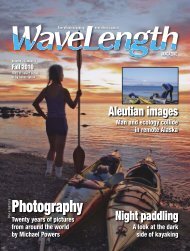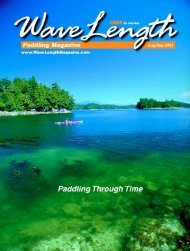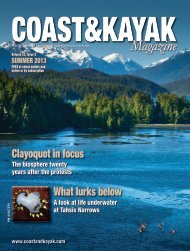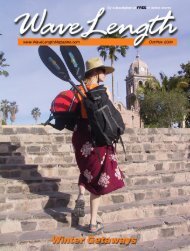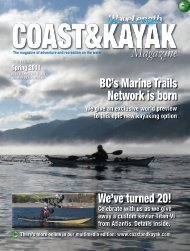download - WaveLength Paddling Magazine
download - WaveLength Paddling Magazine
download - WaveLength Paddling Magazine
You also want an ePaper? Increase the reach of your titles
YUMPU automatically turns print PDFs into web optimized ePapers that Google loves.
Carving a Future<br />
Acouple of tourists park their SUV and<br />
stroll across the parking lot to watch<br />
the men chipping away on a dugout canoe.<br />
They survey the area and see two giant<br />
logs being worked and an array of hand<br />
tools and power tools spread on the bench.<br />
One of them looks at the chainsaws. “You’re<br />
cheating,” he says.<br />
Carl Martin’s black eyes flash a grin as<br />
he answers. “I didn’t see you arrive here on<br />
your horse.”<br />
Carl and his brother Bill are master canoe<br />
carvers, and are working here with four<br />
young apprentices. Along with their brother<br />
Joe, they are among the few Nuu-chahnulth<br />
(the traditional inhabitants of the outer<br />
west coast from Neah Bay, Washington to<br />
the Brooks Peninsula on northern Vancouver<br />
Island) who know how to carve traditional<br />
Nuu-chah-nulth canoes, using authentic<br />
designs and traditional techniques<br />
(aside from the odd power tool). They<br />
learned this from their father and their<br />
grandfathers, by researching canoe designs<br />
from books and museums, and also by trial<br />
and error.<br />
Cultural knowledge, such as the art of<br />
canoe carving, was traditionally passed<br />
down through families by parents and<br />
grandparents. However, a century of removing<br />
children from their families and putting<br />
them into Christian residential schools not<br />
only disrupted this transfer of knowledge,<br />
it also subjected generations of children to<br />
physical and sexual abuse. Although the<br />
residential schools have been closed now<br />
for several decades, the psychological damage<br />
that their students sustained lives on in<br />
the form of addictions to alcohol and other<br />
drugs, and continuing cycles of abuse that<br />
pass through the generations today. Carl and<br />
Bill’s canoe-carving projects are, to them,<br />
an important part of the healing from generations<br />
of abuse—for themselves, for other<br />
family members, and for their community.<br />
The brothers are working on two canoes,<br />
both being carved from a single 800 yearold<br />
red cedar log. The dugouts have been<br />
commissioned by the Tin Wis Best Western<br />
Resort, with funding from the Nuu-chahnulth<br />
Economic Development Corporation,<br />
and are being constructed in a carving shed<br />
beside the hotel’s parking lot in Tofino. The<br />
smaller canoe is 18 feet in length, and the<br />
larger one is 34 feet.<br />
The Martins usually carve their canoes<br />
in remote inlets, close to where the giant<br />
trees grow. It is not often that a canoe is<br />
carved in town where people can watch<br />
the progress, and these two canoes have<br />
generated a lot of interest. Members of local<br />
First Nations communities come to learn<br />
about parts of their culture that were nearly<br />
lost, Tofino locals check in periodically to<br />
witness the process, and tourists are fascinated<br />
to learn about the local native culture.<br />
Carl, Bill and their apprentices are happy to<br />
take time to show visitors around, explaining<br />
the techniques they use and showing<br />
Jacqueline Windh<br />
Carl Martin shapes the stern of the canoe, which will be fitted on to the hull (he<br />
wears a traditional cedar bark hat made by his sister Mary Martin).<br />
photos of other canoes they have built and<br />
canoe gatherings they have attended.<br />
The Tin Wis canoe project is a special<br />
one for Carl and Bill. Although the three<br />
Martin brothers and their late father have<br />
carved over thirty dugouts, until recently<br />
this knowledge seemed to be stuck at their<br />
generation. Now they are working with four<br />
young apprentices, including their nephew➝<br />
February/March 2003 www.<strong>WaveLength</strong><strong>Magazine</strong>.com<br />
5




